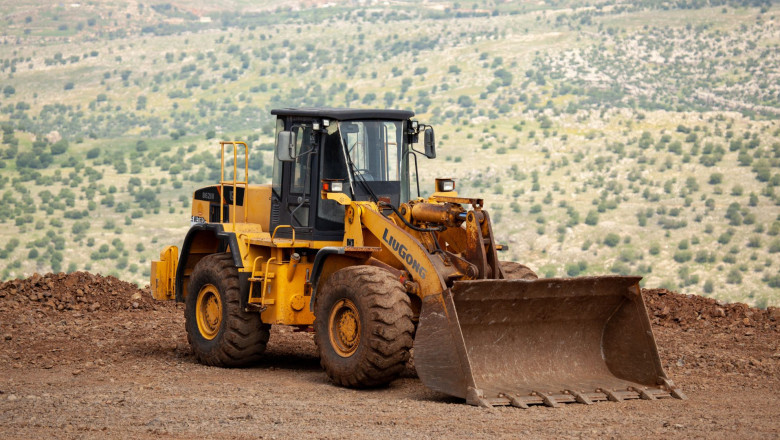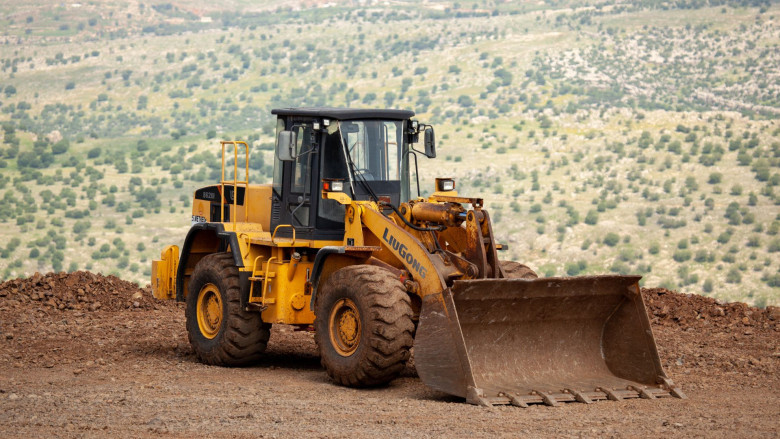views
Introduction
In today’s fast-paced construction environment, machines like the boom loader play a critical role in improving productivity and ensuring precise material handling. Among these, the JCB 540-170 Telehandler Boom Loader stands out for its exceptional lifting capacity, extended reach, and adaptability across various terrains. Whether you're transporting materials to elevated areas or handling bulky loads with efficiency, this heavy-duty boom loader is engineered to meet the demanding needs of modern job sites.
Overview of Boom Loaders in Modern Construction
Boom loaders are ubiquitous on modern construction sites, where timelines are tight and safety is paramount. With the ability to perform multiple functions using various attachments, these machines reduce the need for multiple equipment types. From loading materials onto trucks to placing beams at considerable heights, boom loaders have transformed operational dynamics, making construction more streamlined and productive.
Why Understanding Boom Loader Basics Matters for Operators
Operating a boom loader involves more than pushing levers and steering. Operators must understand machine mechanics, load limitations, terrain interaction, and hydraulic behavior. Missteps can lead to accidents, equipment damage, or project delays. Mastery of the basics empowers operators to work safely, efficiently, and with confidence—ultimately enhancing site productivity and reducing downtime.
What is a Boom Loader?
Definition and Primary Functions of a Boom Loader
A boom loader is a versatile, hydraulically powered machine equipped with an extendable arm or boom, used for lifting and moving heavy loads. Unlike standard loaders, its articulated or telescopic arm offers vertical reach and angular movement, allowing it to access hard-to-reach places. Its adaptability makes it a staple in construction, agriculture, and logistics.
Key Differences Between Boom Loaders and Other Loaders
While front-end loaders and skid steers are designed for horizontal movement and close-range lifting, boom loaders excel in vertical operations. The extendable boom allows for greater reach, often without repositioning the machine. Furthermore, boom loaders support a wide range of attachments—forks, buckets, winches—providing cross-functional capability in dynamic environments.
Core Components of a Boom Loader
Boom Arm and Its Hydraulic Mechanism
At the heart of the boom loader lies the hydraulic-powered boom arm. This extendable structure enables precise control over height and reach. Hydraulic cylinders and pistons convert fluid pressure into mechanical force, allowing the boom to lift heavy materials with minimal operator effort. This dynamic range of motion enhances load placement accuracy and efficiency.
Operator Cab Features and Control System
The operator cab is engineered for functionality and ergonomics. Modern boom loaders include joystick-based controls, touchscreen panels, climate control, and 360-degree visibility to improve safety and comfort. Control systems now integrate load sensors, GPS tracking, and automation support to simplify complex maneuvers.
Tires vs. Tracks: Understanding the Undercarriage Options
Boom loaders come in wheeled or tracked variants. Wheeled loaders offer mobility and speed on firm, level ground, making them ideal for urban and industrial projects. Tracked boom loaders, on the other hand, excel in rugged terrains, offering stability and traction on uneven or muddy surfaces. Selecting the right undercarriage depends on the operational environment.
Types of Boom Loaders and Their Applications
Telescopic Boom Loaders
Telescopic boom loaders, or telehandlers, feature a straight extendable boom that can reach high elevations. They are commonly used to move materials to upper floors, position structural components, or load items onto elevated platforms. Their long reach and heavy-lifting capacity make them indispensable for large-scale construction.
Articulating Boom Loaders
Also known as knuckle boom loaders, these machines have jointed arms that allow for flexible maneuvering around obstacles. They are well-suited for urban construction sites or operations requiring precise movements in tight spaces. Their articulation adds agility, making them ideal for tasks involving complex positioning.
Use Cases Across Industries: Construction, Agriculture, and More
Boom loaders aren’t confined to construction. In agriculture, they assist with hay bale stacking, grain transport, and equipment loading. In mining and forestry, they handle logs and debris. Their utility spans disaster response, landscaping, and warehouse operations—anywhere that lifting and precision placement are needed.
How to Operate a Boom Loader Safely
Pre-Operation Inspection Checklist
Before starting the machine, operators must conduct a thorough inspection. Check hydraulic lines for leaks, verify fluid levels, inspect tires or tracks for wear, test lights and signals, and ensure all attachments are secure. Preventive checks reduce the risk of mid-operation failures.
Starting and Stopping Procedures
Starting the boom loader involves more than turning a key. Engage parking brakes, set the gear to neutral, and check indicator lights. Once operational, slowly activate the boom controls to ensure responsiveness. Shutting down includes idling the engine, disengaging the hydraulic system, and parking on level ground.
Basic Driving and Maneuvering Techniques
Boom loaders are rear-steered, requiring different driving techniques than conventional vehicles. Operators must master the art of counterbalancing loads and navigating tight corners. Gradual acceleration, awareness of boom extension, and maintaining a low center of gravity are crucial for stable operation.
Essential Safety Protocols for Boom Loader Operators
Wearing the Right Protective Gear
Personal protective equipment (PPE) is non-negotiable. Helmets, steel-toed boots, gloves, and high-visibility clothing minimize injury risks. Depending on the task, operators may also require safety harnesses or hearing protection.
Understanding Load Limits and Stability
Every boom loader has a load chart that specifies safe lifting limits based on boom angle and extension. Overloading or improper weight distribution can cause tip-overs. Understanding center of gravity and stability zones is critical to safe operation.
Avoiding Common Hazards on Job Sites
Obstacles like power lines, unstable terrain, or blind spots pose serious risks. Clear communication, signage, and spotters enhance awareness. Operators must stay vigilant, especially when working in confined or busy environments.
Routine Maintenance and Upkeep Tips
Daily Checks Every Operator Should Perform
Simple routines like checking oil levels, cleaning filters, testing brakes, and inspecting tire pressure can prevent costly repairs. Consistency in these checks ensures long-term machine health.
Scheduled Maintenance for Optimal Performance
Manufacturers recommend maintenance at set intervals—typically based on operating hours. These include hydraulic system servicing, engine tuning, and replacement of worn-out parts. Following the maintenance log religiously extends the machine’s lifespan.
Identifying and Reporting Mechanical Issues
Strange noises, sluggish boom movement, or fluid leaks are early warning signs. Operators must report these immediately to prevent escalation. Proactive communication between operators and maintenance teams is vital for uptime.
Licensing and Certification Requirements
Training Programs and Courses Available
Numerous vocational programs and online courses offer comprehensive training on boom loader operation. These cover safety regulations, machine mechanics, and simulation-based learning, ensuring readiness for fieldwork.
Legal Requirements by Region or Country
Some jurisdictions mandate certification or licensing to operate heavy machinery. These regulations are designed to standardize competency and reduce workplace accidents. Employers must stay updated on regional requirements.
Benefits of Being a Certified Boom Loader Operator
Certification enhances employability and earns the trust of supervisors. Certified operators are often considered for higher responsibilities and are eligible for insurance benefits in case of incidents.
Troubleshooting Common Boom Loader Issues
Hydraulic Malfunctions and Solutions
Hydraulic issues—like slow movement or erratic responses—often stem from air in the system, contaminated fluid, or worn seals. Bleeding the system, replacing filters, and checking pressure levels are effective remedies.
Control Panel Errors and Fixes
Error codes on modern digital panels help diagnose issues. Resetting the system, inspecting wiring, or consulting the user manual can resolve many problems without requiring technician intervention.
Dealing with Unusual Noises or Vibrations
Grinding, rattling, or hissing noises may indicate worn bearings, loose components, or hydraulic pressure imbalances. Immediate shutdown and inspection prevent serious breakdowns.
Productivity Tips for New Boom Loader Operators
Optimizing Workflows on the Job Site
Planning load paths in advance, minimizing idle time, and staging materials effectively can dramatically boost efficiency. Smooth coordination with site supervisors streamlines operations.
Time-Saving Techniques for Material Handling
Using the right attachment for the job, maintaining a consistent operating speed, and avoiding overcorrections while maneuvering reduce delays and fuel consumption.
Effective Communication with Ground Crews
Two-way radios, hand signals, and visual cues ensure smooth collaboration. Clear communication prevents mishaps, especially during lifting and unloading.
Future Trends in Boom Loader Technology
Automation and Remote Control Advancements
Boom loaders are entering the era of autonomy. Semi-autonomous controls, remote operation, and geofencing are reshaping how machines are used, especially in hazardous environments.
Eco-Friendly Boom Loaders and Electric Models
Manufacturers are rolling out electric and hybrid boom loaders to reduce carbon footprints. These models also lower noise levels, making them suitable for indoor and urban applications.
Smart Load Monitoring and Telemetry Features
Integrated sensors and IoT devices allow real-time tracking of loads, diagnostics, and machine performance. These smart features support predictive maintenance and data-driven decision-making.
Conclusion
The JCB 540-170 Telehandler Boom Loader is more than just a piece of heavy equipment—it’s a productivity powerhouse built for reliability and performance. With its superior design, versatile attachments, and robust lifting capabilities, it remains a top choice for professionals seeking a dependable boom loader solution.























Comments
0 comment